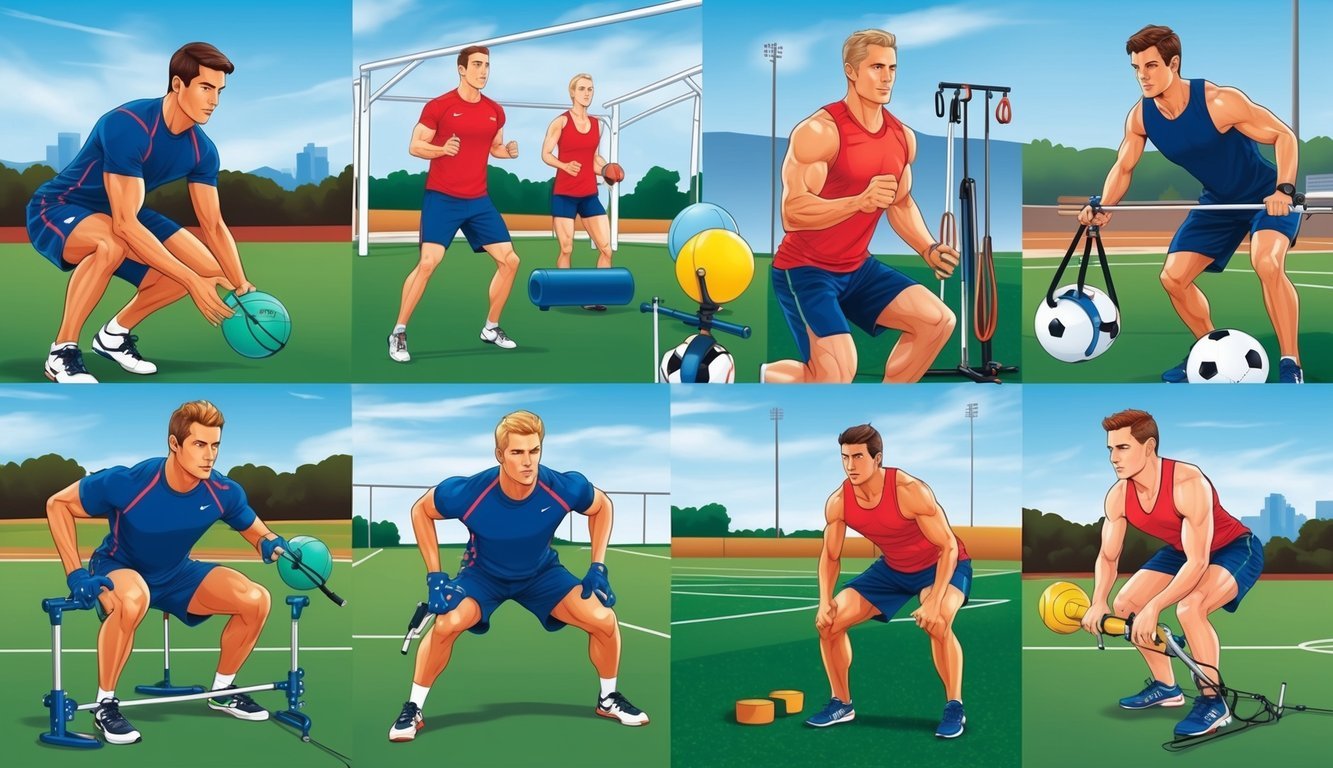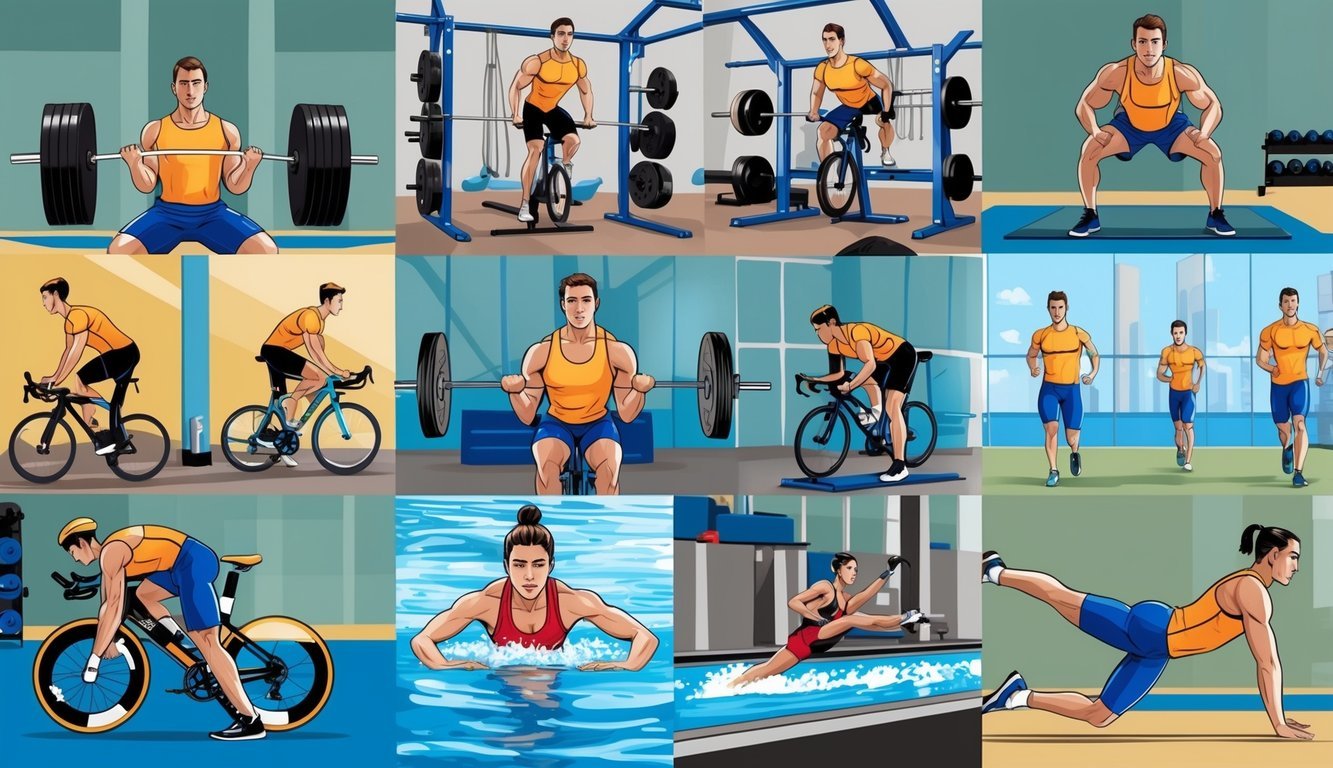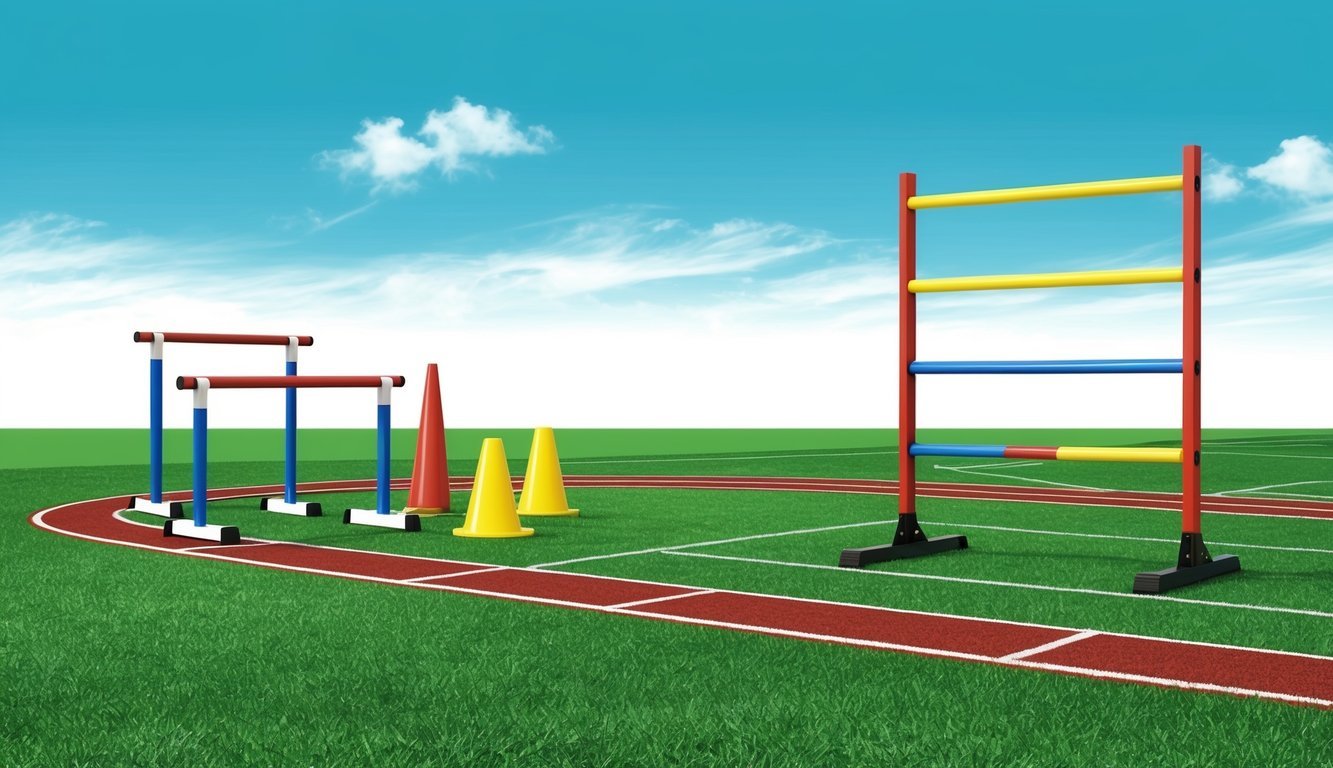As an athlete, I always look for ways to enhance my performance and take my skills to the next level.
Finding the right strategies can make a significant difference in achieving my athletic goals and pushing past my limits.
It’s not just about hard work; specific techniques can help me optimize my training and recovery.

Whether I’m aiming to boost my strength, speed, or endurance, there are proven methods out there that can turn good efforts into great results.
Understanding and applying these strategies can lead to noticeable improvements in my performance and overall health.
1) Interval Training

I find interval training to be one of the most effective ways to boost my running performance.
It involves alternating between high-intensity bursts and recovery periods.
This structured approach keeps my workouts engaging and can lead to significant gains.
When I focus on my lactate threshold pace, I can better manage my efforts.
For example, if I’m running a 10K in 45 minutes, I aim for a tempo pace around 7:30 to 7:35 minutes per mile.
This helps me build speed and endurance over time.
I also pay attention to work-to-rest ratios.
As a beginner, I started with a 1:2 ratio, running hard for 30 seconds followed by a longer recovery.
This method keeps my form sharp and reduces the risk of injury.
During these sessions, I often target specific heart rates.
Aim for about 94 to 98 percent of my maximal heart rate to make the most of my workouts.
It’s crucial to stay within the proper intensity range to truly benefit from interval training.
2) Strength Conditioning
Strength conditioning is crucial for anyone looking to enhance athletic performance.
It goes beyond just lifting heavy weights.
I focus on building functional strength that directly translates to my sport.
I incorporate various exercises that improve muscle endurance and overall power.
This means I engage in movements that mimic the actions I perform in my sport.
For example, squats, deadlifts, and lunges are staples in my routine.
I also pay attention to explosive movements.
Moving weight quickly and with control can help me develop the power I need during competition.
Short, high-intensity sets often feel more beneficial than longer, slower sessions.
Consistency is key.
I make sure to dedicate time each week to my strength training.
That way, I can continuously track my progress and push my limits.
Lastly, balancing strength conditioning with recovery is essential.
My muscles need time to heal and grow stronger, so I always prioritize recovery days.
By treating strength conditioning as an integral part of my training, I maximize my potential as an athlete.
3) Proper Hydration
Staying properly hydrated is crucial for my athletic performance.
Water is my best friend, especially before, during, and after workouts.
I aim to drink 16-20 ounces of water a few hours before exercising.
Then, I make it a point to gulp down another 8-10 ounces about 20 minutes prior.
During my sessions, I try to consume 7-10 ounces every 20 minutes.
When I neglect hydration, I quickly feel the effects.
Dehydration can lead to reduced stamina, increased fatigue, and a harder time concentrating.
My heart has to work extra hard, and that makes everything feel tougher.
It’s not just about thirst; I focus on maintaining my energy levels with regular hydration.
After I finish, replenishing with fluids is essential for recovery.
Incorporating sports drinks can also be helpful, especially during intense activities.
They provide electrolytes that I lose through sweat.
Keeping track of my hydration helps me perform better and feel great during my workouts.
4) Balanced Nutrition

I can’t stress enough how important balanced nutrition is for boosting athletic performance.
It’s not just about eating to fill my stomach; it’s about giving my body the right fuel.
Having a good mix of macronutrients—carbohydrates, proteins, and fats—helps me maintain optimal energy levels.
Carbs are my go-to for quick energy, especially before workouts or competitions.
I also focus on proteins for recovery.
After tough sessions, getting enough protein helps my muscles repair and grow.
Healthy fats keep me satisfied and support long-term energy.
Staying hydrated is key too.
I make it a habit to drink water throughout the day, especially during and after workouts.
It helps keep my performance steady and aids in recovery.
Paying attention to what I eat gives me a serious edge.
It’s all about making those smart choices to keep my body operating at its best.
5) Mental Focus Techniques
When I think about boosting my athletic performance, mental focus comes to mind as a key element.
Staying focused helps me tune out distractions and get into a zone where I can perform my best.
One technique I use is visualization.
I imagine myself successfully completing my sport, which helps me get mentally prepared.
It’s like a mental rehearsal that sets the tone for my performance.
Another tool is goal setting.
I break down big goals into smaller, achievable ones.
This keeps me motivated and provides a clear path to follow.
I also practice self-talk.
Positive affirmations remind me of my capabilities, especially before competition.
It’s amazing how changing my inner dialogue can shift my mindset.
Relaxation techniques help, too.
When I feel tension brewing, I take a moment to breathe deeply and center myself.
This clears my mind and brings my focus back.
Lastly, I find that developing routines before performance really helps me lock in that focus.
Consistency brings comfort, allowing me to zone in on what I need to do without overthinking it.
Stretching Routines

Incorporating stretching routines into my training has made a noticeable difference in my athletic performance.
I focus on a mix of static and dynamic stretches to enhance flexibility and reduce the risk of injury.
Before workouts, I usually start with dynamic stretches.
These help warm up my muscles and improve my range of motion.
After my workouts, I shift to static stretching, targeting all major muscle groups.
I make sure to hold each stretch for at least 30 seconds.
This allows my muscles to lengthen and helps with recovery.
For instance, I enjoy the side neck stretch, which eases tension and improves mobility.
Paying attention to my hips and glutes is crucial, so I include stretches like the seated forward bend.
This not only feels great but also prepares me for more strenuous activities.
Lastly, I ensure I cover all critical areas to avoid imbalances.
By sticking to a structured routine, I feel more limber and ready for whatever challenge comes next.
7) Cross-Training Activities

I’ve found that cross-training can really make a difference in my athletic performance.
It helps me engage different muscle groups and adds variety to my routine.
Swimming is one of my go-to activities.
It’s great for building endurance without stressing my joints.
Plus, it’s refreshing, especially on hot days.
I also enjoy cycling.
It’s an excellent way to improve my leg strength while giving my body a break from high-impact workouts.
Rowing is another favorite.
A quick session on the rower gets my heart rate up and works my upper body as well.
Incorporating these activities helps me avoid burnout and reduces the risk of injuries.
By mixing things up, I can keep my workouts interesting and fun.
8) Consistent Sleep Patterns

I’ve found that sticking to a consistent sleep schedule is crucial for my athletic performance.
When I go to bed and wake up at the same time every day, my body gets into a natural rhythm.
This helps me feel more energized.
I aim to get an extra 30 to 60 minutes of sleep each night.
This little boost can really enhance my recovery and endurance.
It’s surprising how much better I perform after a solid night’s rest.
Reducing caffeine intake and cutting down on screen time before bed has also made a difference.
I try to unwind with a book or some light stretching instead.
Creating a bedtime routine helps signal to my body that it’s time to sleep.
Whether it’s dimming the lights or using blackout curtains, these small changes contribute to a better night’s rest.
When I prioritize sleep like this, I notice improvements in my focus and mood.
Consistency in my sleep patterns is one of the best strategies I’ve adopted for optimizing my performance.
9) Injury Prevention Strategies

Injuries can really throw a wrench in my training and performance.
I’ve learned that injury prevention is all about being proactive.
First, I pay close attention to my conditioning.
Keeping fit helps me handle the demands of my sport better.
Warming up and cooling down are key parts of my routine.
I always take time before and after workouts to prevent strains and sprains.
Rest and recovery are non-negotiable for me.
I make sure to listen to my body and take breaks when needed.
Proper technique is something I focus on as well.
It’s crucial to understand the biomechanics of the movements I perform.
Gradual progression is my go-to advice when starting new exercises.
I avoid jumping into intense workouts right away, especially with activities like running or cycling.
Lastly, I regularly assess my equipment.
Having the right gear can make a significant difference in preventing injuries.
Defining Key Performance Metrics
When I think about athletic performance, I consider several key metrics.
These are essential for measuring an athlete’s effectiveness:
- Speed: Athletes need to cover a distance quickly. This is often critical in sports like sprinting or soccer.
- Strength: This refers to the amount of force exerted in activities. It is necessary for weightlifting and contact sports.
- Endurance: The ability to sustain prolonged physical exertion. This is important for long-distance runners and cyclists.
- Agility: An athlete’s ability to change direction quickly. This is essential in team sports such as basketball and football.
Tracking these metrics provides insights into areas for improvement and can guide training regimens to enhance overall performance.
The Role of Genetics and Physiology
My understanding of athletic performance also highlights the significant influence of genetics and physiology.
Genetics determines various physical traits, such as muscle fiber composition and cardiovascular capacity.
For example, fast-twitch muscle fibers are advantageous for strength and power sports, while slow-twitch fibers benefit endurance activities.
Physiological factors, such as lung capacity and heart efficiency, play crucial roles too.
These aspects can shape an athlete’s potential, dictating how they respond to training stimulus.
While hard work is vital, recognizing these inherent traits helps tailor training methods for optimal results.
Training and Conditioning Techniques
To elevate athletic performance, I find it crucial to incorporate targeted training and conditioning techniques.
Focusing on strength and endurance is key, as each aspect supports an athlete’s overall capabilities and resilience.
Additionally, integrating agility drills and flexibility exercises helps enhance mobility and reduce the risk of injury.
By maintaining a well-balanced regimen that includes proper nutrition and recovery strategies, athletes can boost physical endurance effectively.
Consistent effort and smart training approaches contribute to sustained improvements in performance and overall athletic success.
Optimizing Strength Training
In my experience, effective strength training blends various methods to enhance muscle power and endurance.
High-intensity interval training (HIIT) is one of my go-to strategies.
It involves short bursts of intense activity followed by rest, maximizing strength gains in minimal time.
Plyometrics are another favorite of mine.
These explosive movements, like jump squats or box jumps, help build fast-twitch muscle fibers, essential for many sports.
Weightlifting is foundational.
I focus on compound movements like squats and deadlifts to engage multiple muscle groups.
Key Exercises to Include:
- Squats
- Deadlifts
- Bench Press
- Pull-Ups
Tracking progress is essential.
I use a training log to monitor increases in weight and repetitions, ensuring continuous improvement.
Enhancing Endurance and Stamina
Endurance training has changed my overall performance.
I incorporate long-distance running or cycling into my routine.
This helps build cardiovascular capacity.
I make sure to include various durations and intensities.
This keeps my body challenged.
Incorporating interval training can spice things up.
I alternate between high-intensity efforts and recovery periods.
This not only boosts stamina but also enhances recovery times.
I also focus on active recovery techniques.
For example, I do light jogging or swimming post-hard workouts.
Endurance Training Tips:
- Mix steady-state runs with interval sessions.
- Stay hydrated—dehydration can hinder performance.
- Ensure proper nutrition to fuel long workouts.

